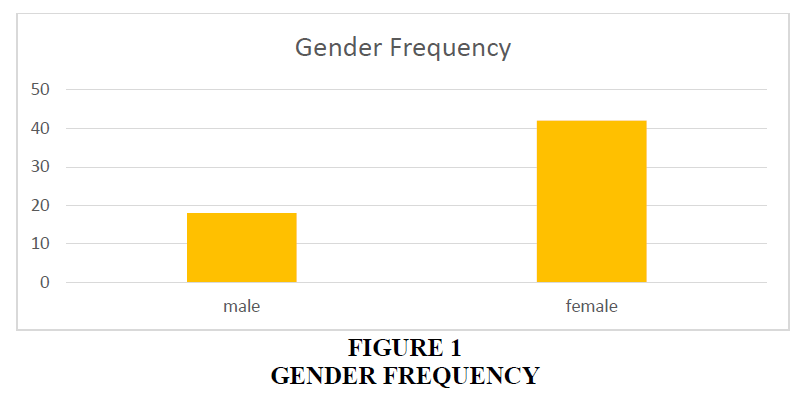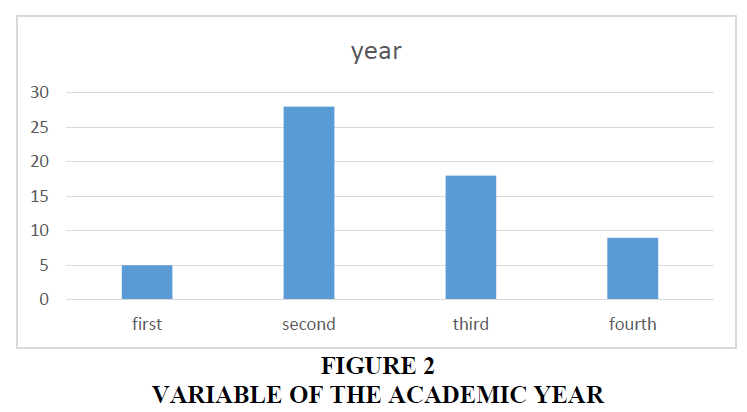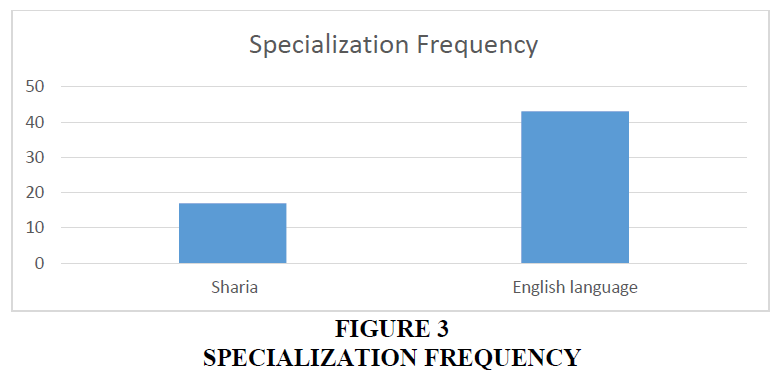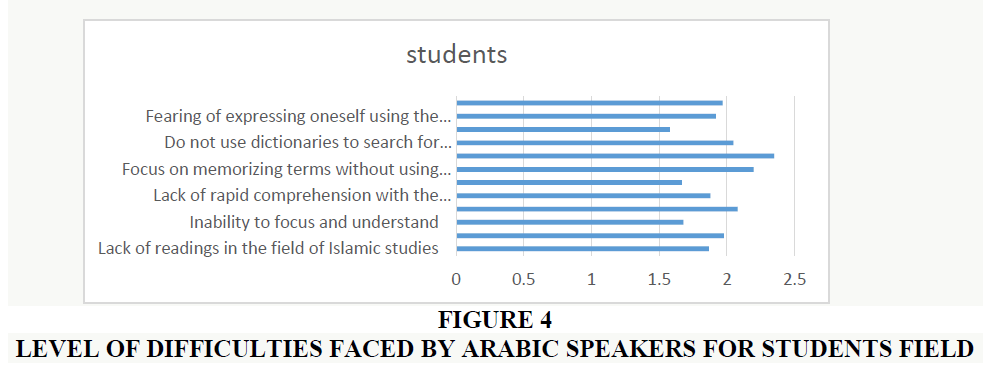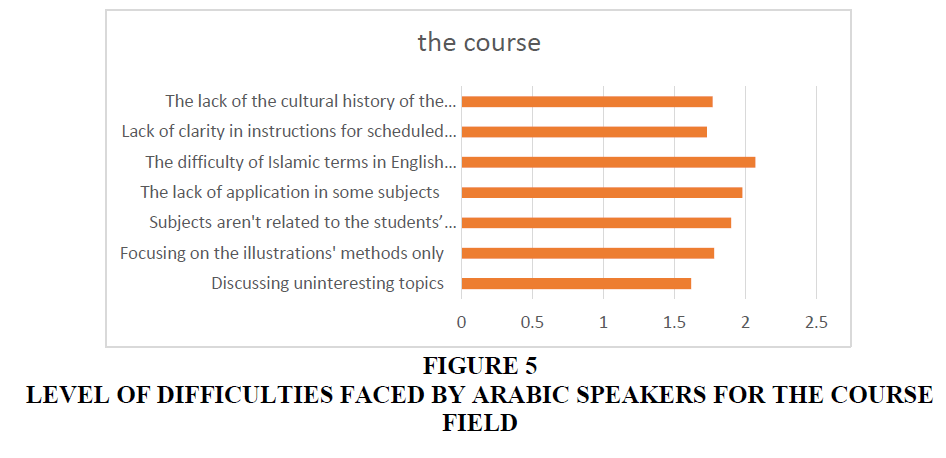Research Article: 2023 Vol: 26 Issue: 2
The Difficulties that Face Arabic-Speaking Students in Islamic Studies in English
Ibtehaj Radi, The World Islamic Sciences and Education University
Citation Information: Radi, I. (2023). The difficulties that face Arabic-speaking students in Islamic studies in English. Journal of Legal, Ethical and Regulatory Issues, 26(2), 1-11.
Abstract
This study is concerned with investigating the difficulties that face Arabic-speaking students in Islamic studies in English. There are many difficulties related to students, the course, and the environment. This paper attempts to answer the following questions: What are the difficulties that Arabic speakers face in Islamic studies in English? Are there any statistically significant differences in the difficulties that Arabic speakers face in Islamic studies in English due to the variable of gender, academic year and specialization? The results of study revealed that the level of difficulties faced by Arabic speakers in Islamic studies in English in the students’ field, the course field are low, but in the surrounding environment field is high. Also, the results of study showed that there are no statistically significant differences in the difficulties faced by Arabic speakers in Islamic studies in English due to the variable of gender, specialization and academic year.
Keywords
Difficulties, Arabic-Speaking Students, Islamic Studies.
Introduction
The idea of this research refers and springs from teaching Islamic studies in English, because WISE University is interested in other languages; as they are the means to know cultures. This paper attempts to answer the following questions:
1. What are the difficulties that Arabic speakers face in Islamic studies in English?
2. Are there any statistically significant differences in the difficulties that Arabic speakers face in Islamic studies in English due to the variable of gender, academic year and specialization?
Types of Difficulties: Difficulties Related to Students
While learning a second language, a student faces many difficulties like socio-cultural problems, unfamiliarity with the subject, different style of writing from his mother tongue, pronunciation problem, problem in recognizing the alphabets etc. (Elttayef & Hussein, 2017).
For Islamic studies in English is totally different from the culture of the language which the students are learning, in addition, the Lack of readings in the field of Islamic studies, and not using dictionaries to search for meanings of vocabulary, also Not understanding some Islamic terms, focusing on memorizing terms without using them, and Students tend to talk to each other during the lecture in Arabic.
Besides that, the Inability to focus, understand, and Failure to obey the teacher's instructions. Additionally, the Lack of rapid comprehension with the speed of the speaker (Al-Hosni, 2014), and the Difficulty of dealing with illustration's methods.
Also, Weakness in dictating and spelling Islamic terms in English. Therefore, students focus on the exam only and fail to express themselves using the English language, as Alenazi (2018) study.
Difficulties Related to the Course
English has become a global language and teaching it as foreign or second language has increasingly become a universal demand. Many textbooks have been designed for teaching English as a foreign language in many countries all over the world (Fareh, 2010). There are many studies (Ansari, 2012) concerned with investigating the difficulties that learners of English may face (Al-Tameemi & Farhan, 2018). However, for Islamic studies Curriculum needs experts that solve the difficulties related to this course.
Besides that, the main difficulties that occur are in Islamic course that is discussing uninteresting topics and the difficulty of Islamic terms in English language. Also, focusing on the illustrations' methods only, and Lack of clarity in instructions for scheduled exercises and activities. And so, Subjects aren't related to the students’ daily lives. Additionally, the insufficient knowledge of some subjects. Because, the lack of the cultural history of the student himself therefore, we need to make Islamic courses for teachers and enable them to teach the new Islamic course and focus on the role of English Language teaching for Islamic studies (Elttayef & Hussein, 2017).
Difficulties Related to the Environment
These days’ environmental changes have greatly increased which attracted the attention of all countries in the world. Countries of the Muslim world are no exception and, similar to other countries, face unprecedented pressures resulting from environmental changes (Taghehbaf, 2014). For Islamic studies the first challenge Lack of money to take courses in foreign countries in English, and working during the study period. In addition, having no opportunity for the students to practice the English language, because the classes are crowded; so, Lack of suitable environment for practicing the English language. Another reason is Scarcity of teachers speak English natively in lectures. Therefore, the lack of gradation in the curriculum from easy to difficult. Furthermore, the difficulty of the selected topics, Lack of fun in the lectures, and No rewards for creativity.
Finally, about one-third of Bachelor degree courses are taught in Arabic, especially in Faculties of Arts and Education. These courses include Islamic Studies, Arabic, Social Studies, History, Computer Science and Education. I think that the remainder of the courses is not enough to help graduates communicate freely and effectively in the target language. They are thus likely to face difficulties in their performance. I suggest that it would be more helpful if such courses were taught in English rather than in Arabic. In discussing ways of learning a foreign language (Rababah, 2002).
Literature Review
Exploring the Challenges Facing Arabic-Speaking ESL Students & Teachers in Middle School
The purpose of this study was to uncover challenges facing Arabic-speaking ESL students as well as teachers in the middle school classroom. Research questions focused on the needs of the Arabic-speaking ESL students, the factors that influence their learning, and the problems the teachers face in supporting these students. Data sources included teacher and student interviews, classroom observations, and a parent survey. Data showed that the students face challenges to learn the English language, the culture, and curricular content using their limited English. The study concluded that several important challenges for teachers and students exist, including time, language support, and knowledge (Akasha, 2013).
Spelling Difficulties Faced by Arab Learners of English as a Foreign Language
This paper aims to highlight the difficulties that Arab learners of English encounter when spelling English words. It describes some spelling approaches such as whole word approach, phonics approach, invented spelling approach, traditional approach and morphemic approach. Then, it considers the different kinds of spelling errors often made by Arab learners of English. It concludes with some suggestions for helping Arab learners of English improve their spelling skills (Alenazi, 2018). As for this research, The difference is that our study clarifies the difficulties that face Arabic-speaking students in Islamic studies in English, in WISE University.
The results of this study revealed that the level of difficulties faced by Arabic speakers in Islamic studies in English in the students’ field, the course field are low, but in the surrounding environment field is high.
Islamic Studies in English Course
This course provides students with a general introduction to the religion of Islam and Islamic studies. It starts with a brief introduction talk about the sources of Islam. The course discusses the origin and the meaning of the word Quran both linguistically and technically, it also gives an introduction to the Qur'an, Sunnah, pillars of Islam, pillars of faith, besides Questions and Activities for every Unit.
This course, therefore, we need it to discuss and demonstrate the main issues needed to build the real and true foundations in the minds and hearts of Muslims and others, and then to discuss the issues which form a real challenge to Muslim nation and religion (Al-Tantawi, 1997).
Research Methodology
The type of this research used a survey approach; it includes a Questionnaire indicating the level of difficulties that face Arabic-speaking students in Islamic studies in English (Sugiyono, 2010). This study focused on WISE Arabic students only, consisted of (18) males (30%), and (42) females (70%). It Consisted of (17) students from the Sharia specialization with a percentage of 28.3%, and (43) students from the English language specialization with a percentage of (71.7%).
Instrument and Procedures
The data was collected from students by anonymous questionnaire. The survey was anonymous and voluntary. The questionnaire consisted of multiple parts: the difficulties that Arabic speakers face in Islamic studies in English for students’ field, the first part, and basic information about respondents was collected. Different answers were offered to choose from, as described in the Tables below. The scale of alternative (High or low) shows: What are the difficulties that Arabic speakers face in Islamic studies in English? This question is answered by collecting and analyzing the data and extracting the arithmetic averages, standard deviations, and descending order. The researcher also found the degree of difficulty, which is divided into two parts: high (2-3) and low (1-2) as in the following Tables.
The Study Samples
In Table 1 the study sample consisted of (18) males (30%), and (42) females (70%). The Figure 1 below illustrates this.
| Table 1 The Study Sample According to Gender Variable | ||
| Frequency | Percent | |
| Male | 18 | 30.0 |
| Female | 42 | 70.0 |
| Total | 60 | 100.0 |
In Table 2 the sample of the study consisted of (5) first-year students with a rate of 8.3%, and (28) second-year students with a rate of 46.7%, while the number of third-year students is (18) with a percentage of 30%, and the number of fourth-year students is (9) with a percentage of 15%. The Figure 2 shows this.
| Table 2 The Study Sample According to the Variable of the Academic Year | ||
| Year | Frequency | Percent |
| First | 5 | 8.3 |
| Second | 28 | 46.7 |
| Third | 18 | 30.0 |
| Fourth | 9 | 15.0 |
| Total | 60 | 100.0 |
In Table 3 the study sample consisted of (17) students from the Sharia specialization with a percentage of 28.3%, and (43) students from the English language specialization with a percentage of (71.7%). The Figure 3 illustrates this.
| Table 3 The Study Sample According to the Variable of Specialization | ||
| Frequency | Percent | |
| Sharia | 17 | 28.3 |
| English language | 43 | 71.7 |
| Total | 60 | 100.0 |
Results
Results related to the first question: What are the difficulties that Arabic speakers face in Islamic studies in English? This question is answered by collecting and analyzing the data and extracting the arithmetic averages, standard deviations, and descending order. The researcher also found the degree of difficulty, which is divided into two parts: high (2-3) and low (1-2) as in the following Tables.
Table 4 mean, standard deviation, decreasing arrange and degree of the difficulties that face Arabic-speaking students in Islamic studies in English for students’ field.
| Table 4 Level of Difficulties Faced by Arabic Speakers for Students Field | |||||
| No | Items | Mean | SD | D. Arrange | Degree |
| 1 | Lack of readings in the field of Islamic studies | 1.87 | 0.68 | 9 | L |
| 2 | Not understanding some Islamic terms | 1.98 | 0.62 | 5 | L |
| 3 | Inability to focus and understand | 1.68 | 0.60 | 10 | L |
| 4 | Focus on the exam only | 2.08 | 0.81 | 3 | H |
| 5 | Lack of rapid comprehension with the speed of the speaker | 1.88 | 0.76 | 8 | L |
| 6 | Difficult dealing with illustration's methods | 1.67 | 0.75 | 11 | L |
| 7 | Focus on memorizing terms without using them | 2.20 | 0.68 | 2 | H |
| 8 | Students tend to talk to each other during the lecture in Arabic | 2.35 | 0.76 | 1 | H |
| 9 | Do not use dictionaries to search for meanings of vocabulary | 2.05 | 0.81 | 4 | H |
| 10 | Failure to obey the teacher's instructions | 1.58 | 0.72 | 12 | L |
| 11 | Fearing of expressing oneself using the English language | 1.92 | 0.85 | 7 | L |
| 12 | Weakness in dictating Islamic terms in English | 1.97 | 0.78 | 6 | L |
| 1.94 | 0.43 | L | |||
The results of the Table 4 show that the level of difficulties faced by Arabic speakers in Islamic studies in English in the students’ field is low, with an average (1.94) and the standard deviation (0.43). The results show the most difficult aspects; Students tend to talk to each other during the lecture in Arabic came first with an average (2.35) and standard deviation (0.76). Secondly, focusing on memorizing terms without using them with an average (2.20) and a standard deviation (0.68). Thirdly, Focusing on the exam only with an average (2.08) and a standard deviation (0.81), all of them have high degree.
The least difficulties that students face is Failure to obey the teacher's instructions with an arithmetic mean (1.58) and a standard deviation (0.72), followed by the difficult dealing with illustration's methods with an average of (1.67) and a standard deviation (0.75), followed by the Inability to focus and understand with mean (1.68) and standard deviation (0.60), all low, and the Figure 4 shows this.
Table 5 mean, standard deviation, decreasing arrange and degree of the difficulties that face Arabic-speaking students in Islamic studies in English for the course field.
| Table 5 Level of Difficulties Faced by Arabic Speakers for the Course Field | |||||
| No | Items | Mean | SD | D. Arrange | Degree |
| 1 | Discussing uninteresting topics | 1.62 | 0.78 | 7 | L |
| 2 | Focusing on the illustrations' methods only | 1.78 | 0.69 | 4 | L |
| 3 | Subjects aren't related to the students’ daily lives | 1.90 | 0.84 | 3 | L |
| 4 | The lack of application in some subjects | 1.98 | 0.81 | 2 | L |
| 5 | The difficulty of Islamic terms in English language | 2.07 | 0.76 | 1 | H |
| 6 | Lack of clarity in instructions for scheduled exercises and activities | 1.73 | 0.76 | 6 | L |
| 7 | The lack of the cultural history of the student himself | 1.77 | 0.70 | 5 | L |
| 1.84 | 0.50 | L | |||
The results of the Table 5 showed that the level of difficulties faced by Arabic speakers in Islamic studies in English in the course field is low, where the arithmetic mean is (1.84) and the standard deviation is (0.50). The students encountered the difficulty of Islamic terms in English language with an arithmetic mean (2.07) and a standard deviation (0.76) with a high degree, followed by the lack of application in some subjects with an arithmetic mean (1.98) and a standard deviation (0.81) with a low degree. As for the least difficulties that students face is discussing uninteresting topics with an arithmetic mean (1.62) and a standard deviation (0.78), followed by the lack of clarity in instructions for scheduled exercises and activities with an arithmetic mean (1.73) and a standard deviation (0.76) with a low score. The following Figure 5 illustrates this.
Table 6 mean, standard deviation, decreasing arrange and degree of the difficulties that face Arabic-speaking students in Islamic studies in English for surrounding environment field
| Table 6 Level of Difficulties Faced by Arabic Speakers for Surrounding Environment Field | |||||
| No | Items | Mean | SD | D. Arrange | Degree |
| 1 | Lack of money to take courses in foreign countries in English | 2.58 | 0.59 | 1 | H |
| 2 | Having no opportunity for the students to practice the English language | 2.20 | 0.78 | 3 | H |
| 3 | the class are crowded | 1.80 | 0.78 | 10 | L |
| 4 | The lack of gradation in the curriculum from easy to Difficult | 1.82 | 0.75 | 9 | L |
| 5 | The difficulty of the selected topics | 1.67 | 0.68 | 12 | L |
| 6 | Lack of suitable environment for practicing the English language | 2.32 | 0.79 | 2 | H |
| 7 | Scarcity of teachers speak English natively in lectures | 1.82 | 0.79 | 7 | L |
| 8 | Lack of fun in the lectures | 1.68 | 0.70 | 11 | L |
| 9 | No rewards for creativity | 2.18 | 0.68 | 5 | H |
| 10 | working during the study period | 1.88 | 0.74 | 6 | L |
| 11 | Converting methods of Teaching from direct to E- learning | 2.20 | 0.73 | 4 | H |
| 2.01 | 0.36 | H | |||
The results of the Table 6 showed that the level of difficulties faced by Arabic speakers in Islamic Studies in English in the surrounding environment field is high, where the arithmetic mean is (2.01) and the standard deviation is (0.36). students face lack of money to take courses in foreign countries in English with an arithmetic mean (2.58) and a standard deviation (0.59), followed by the lack of suitable environment for practicing the English language with an arithmetic mean (2.32) and a standard deviation (0.79), followed by the paragraph having no opportunity for the students to practice the English language with an arithmetic mean (2.20) and a standard deviation (0.87), all of them are high degree, and the least difficulties that students face is the difficulty of the selected topics with an arithmetic mean (1.67). And a standard deviation (0.68), followed by the lack of fun in the lectures with an arithmetic mean (1.68) and a standard deviation (0.70), followed by the class are crowded with an arithmetic mean (1.80) and a standard deviation (0.7). 8), all of them are low score. The following Figure 6 illustrates this.
Results related to the second question, which states: Are there any statistically significant differences in the difficulties that Arabic speakers face in Islamic studies in English due to the variable of gender, academic year and specialization?
To answer the question, the data were collected, unloaded and analyzed using arithmetic means, standard deviations, T test for each gender and specialization variable, and one way anova for the academic year variable as in the following Tables.
Table 7 mean, standard deviation and T test of the difficulties that face Arabic-speaking students in Islamic studies in English field according to gender variable
| Table 7 Level of Difficulties Faced by Arabic Speakers Due to the Gender | ||||||
| Items | Gender | N | Mean | Std. Deviation | T | Sig. |
| Students | male | 18 | 1.90 | 0.43 | -0.387 | 0.700 |
| female | 42 | 1.95 | 0.44 | |||
| The course | male | 18 | 1.87 | 0.46 | 0.374 | 0.710 |
| female | 42 | 1.82 | 0.52 | |||
| Surrounding Environment | male | 18 | 2.06 | 0.43 | 0.655 | 0.515 |
| female | 42 | 1.99 | 0.33 | |||
| Total | male | 18 | 1.95 | 0.36 | 0.175 | 0.862 |
| female | 42 | 1.94 | 0.37 | |||
It is noticed from the Table 7 that there are no statistically significant differences in the difficulties faced by Arabic speakers in Islamic studies in English due to the gender.
Table 8 mean, standard deviation and T test of the difficulties that face Arabic-speaking students in Islamic studies in English field according to Specialization variable
| Table 8 Level of Difficulties Faced by Arabic Speakers Due to Specialization Variable | ||||||
| Items | Specialization | N | Mean | Std. Deviation | T | Sig. |
| Students | Sharia | 17 | 2.03 | 0.44 | 1.104 | 0.274 |
| English language | 43 | 1.90 | 0.43 | |||
| The course | Sharia | 17 | 1.95 | 0.46 | 1.106 | 0.273 |
| English language | 43 | 1.79 | 0.52 | |||
| Surrounding environment | Sharia | 17 | 1.99 | 0.30 | -0.325 | 0.746 |
| English language | 43 | 2.02 | 0.39 | |||
| Total | Sharia | 17 | 2.00 | 0.31 | 0.763 | 0.449 |
| English language | 43 | 1.92 | 0.38 | |||
It is noticed from the Table 8 that there are no statistically significant differences in the difficulties faced by Arabic speakers in Islamic studies in English due to the variable of specialization.
Table 9 one way anova for the difficulties that face Arabic-speaking students in Islamic studies in English field according to year’s variable.
| Table 9 Level of Difficulties Faced by Arabic Speakers According to Years Variable | ||||||
| Sum of Squares | df | Mean Square | F | Sig. | ||
| Students | Between Groups | 0.087 | 3 | 0.029 | 0.147 | 0.931 |
| Within Groups | 11.029 | 56 | 0.197 | |||
| Total | 11.116 | 59 | ||||
| The Course | Between Groups | 0.080 | 3 | 0.027 | 0.100 | 0.959 |
| Within Groups | 14.811 | 56 | 0.264 | |||
| Total | 14.891 | 59 | ||||
| Surrounding Environment | Between Groups | 0.179 | 3 | 0.060 | 0.444 | 0.723 |
| Within Groups | 7.537 | 56 | 0.135 | |||
| Total | 7.716 | 59 | ||||
| Total | Between Groups | 0.002 | 3 | 0.001 | 0.004 | 1.000 |
| Within Groups | 7.732 | 56 | 0.138 | |||
| Total | 7.734 | 59 | ||||
It is noticed from the Table 9 that there are no statistically significant differences in the difficulties faced by Arabic speakers in Islamic studies in English due to the variable of academic years.
Conclusion
This study indicates that there are many difficulties that face Arabic-speaking students in Islamic studies in English. It is found that the level of difficulties faced by Arabic speakers in Islamic studies in English in the students’ field is low. The results show the most difficult aspects; Students tend to talk to each other during the lecture in Arabic come first. Also, the level of difficulties faced by Arabic speakers in Islamic studies in English in the course field is low. The students encountered the difficulty of Islamic terms in English language with a high degree, followed by the lack of application in some subjects.
Furthermore, the results find that the level of difficulties faced by Arabic speakers in Islamic Studies in English in the surrounding environment field is high; students face lack of money to take courses in foreign countries in English, followed by the lack of suitable environment for practicing the English language. Besides that, the results of study shows that there are no statistically significant differences in the difficulties faced by Arabic speakers in Islamic studies in English due to the variable of gender, specialization, and academic year.
Recommendation
1. The ministry of education should train teachers of English to deal with Islamic studies topics.
2. Introducing pictures and linked internet in the Islamic studies textbook topics.
3. Attracting Attention in Islamic studies at technology methods in learning and teaching environments.
References
Akasha, O. (2013). Exploring the challenges facing Arabic-speaking ESL students & teachers in middle school. Journal of ELT and Applied Linguistics, 1(1), 12-31.
Al-Hosni, S. (2014). Speaking difficulties encountered by young EFL learners. International Journal on Studies in English Language and Literature, 2(6), 22-30.
Alenazi, O.S. (2018). Spelling difficulties faced by Arab learners of English as a foreign language. Arab World English Journal, 9(2), 1-9.
Indexed at, Google scholar, Cross ref
Al-Tameemi, I.M., & Farhan, M. (2018). Difficulties faced by Iraqi EFL learners in translating English barnyard verbs. Al-Mustansiriya Journal of Arts, 83, 1-24.
Al-Tantawi, S.A. (1997). A general introduction to Islam. Al-Manara Publishing & Distributing House. Jeddah.
Ansari, A.A. (2012). Teaching of English to Arab students: Problems and remedies. Educational Research, 3(6), 519-524.
Elttayef, A.I., & Hussein, N.O. (2017). Arab learners’ problems in learning English language: A teacher perspective. Journal of Literature, Languages and Linguistics, 40, 1-6.
Fareh, S. (2010). Challenges of teaching English in the Arab world: Why can’t EFL programs deliver as expected? Procedia-Social and Behavioral Sciences, 2(2), 3600-3604.
Indexed at, Google scholar, Cross ref
Rababah, G. (2002). Communication problems facing Arab learners of English.
Sugiyono, S. (2010). Educational research methods: Quantitative, qualitative, and R & D approaches. Bandung: CV. Alfabeta.
Taghehbaf, A. (2014). Study and analysis of environmental challenges and the causes of their occurrence in Islamic countries. Indian Journal of Science Research, 4(6), 687-693.
Received: 14-Dec-2022, Manuscript No. JLERI-22-12997; Editor assigned: 16-Dec-2022, PreQC No. JLERI-22-12997(PQ); Reviewed: 28- Dec-2022, QC No. JLERI-22-12997; Revised: 03-Jan-2023, Manuscript No. JLERI-22-12997(R); Published: 10-Jan-2023
